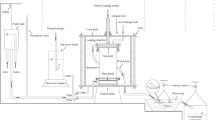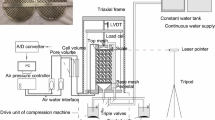Abstract
Internal erosion may affect soil hydraulic properties, inducing localized deterioration and even failure of hydraulic geo-structures. Soil is always subjected to stress in engineering practice; however, the effect of stress on the internal erosion-induced change in soil hydraulic properties along seepage path has not been thoroughly investigated in the literature. In this study, downward seepage-induced internal erosion tests on gap-graded cohesionless soil were conducted using a triaxial permeameter with measurable local hydraulic gradients and deformations. Effects of confining stress on global and local responses of internal erosion were investigated regarding global and local hydraulic gradients and soil deformations as well as eroded fine particles. The results show that the development of seepage velocity during internal erosion exhibits a two-stage linear progression with increasing applied hydraulic gradient under lower confining stress, while it exhibits a single-stage linear progression under higher confining stress. As confining stress increases, both initiation and failure hydraulic gradients are significantly increased, and the onset of the nonuniform distribution of local hydraulic gradients is delayed. Higher confining stress leads to a lower cumulative loss of fine particles and a smaller volume shrinkage, concurrently decreasing the degree of the nonuniform distribution of local hydraulic gradients. Spatial nonuniformity of local hydraulic conductivity and deformations indicates that specimens become more heterogeneous due to the migration of fine particles. Furthermore, although specimens subjected to confining stress exhibit volume shrinkage during internal erosion, the post-erosion void ratio of specimens increases due to the dominant effect of fine particles loss on soil pores.















Similar content being viewed by others
Data availability
Some or all data, models, or codes that support the findings of this study are available from the corresponding author upon reasonable request.
References
ASTM D4767-11 (2011) Standard test method for consolidated undrained triaxial compression test for cohesive soils Annual Book of ASTM Standards ASTM International, West Conshohocken
ASTM D2487-17 (2017) Standard practice for classification of soils for engineering purposes (Unified Soil Classification System) Annual Book of ASTM Standards ASTM International, West Conshohocken
Benamar A, Correia dos Santos RN, Bennabi A, Karoui T (2019) Suffusion evaluation of coarse-graded soils from Rhine dikes. Acta Geotech 14(3):815–823. https://doi.org/10.1007/s11440-019-00782-1
Bendahmane F, Marot D, Alexis A (2008) Experimental parametric study of suffusion and backward erosion. J Geotech Geoenviron Eng 134(1):57–67. https://doi.org/10.1061/(ASCE)1090-0241(2008)134:1(57)
Burenkova VV (1993) Assessment of suffusion in non-cohesive and graded soils. Filters in Geotechnical and Hydraulic Engineering. Brauns, Heibaum and Schuler, Balkema, Rotterdam, pp 357–360
Chang DS, Zhang LM (2011) A stress-controlled erosion apparatus for studying internal erosion in soils. Geotech Test J 34(6):579–589. https://doi.org/10.1520/GTJ103889
Chang DS, Zhang LM (2013a) Critical hydraulic gradients of internal erosion under complex stress states. J Geotech Geoenviron Eng 139(9):1454–1467. https://doi.org/10.1061/(ASCE)GT.1943-5606.0000871
Chang DS, Zhang LM (2013b) Extended internal stability criteria for soils under seepage. Soils Found 53(4):569–583. https://doi.org/10.1016/j.sandf.2013.06.008
Chen C, Zhang LM, Zhu H (2017) A photographic method for measuring soil deformations during internal erosion under triaxial stress conditions. Geotech Test J 41(1):43–54. https://doi.org/10.1520/GTJ20170031
Chen R, Liu L, Li Z, Deng G, Zhang Y (2021) A novel vertical stress-controlled apparatus for studying suffusion along horizontal seepage through soils. Acta Geotech 16(7):2217–2230. https://doi.org/10.1007/s11440-021-01164-2
Deng G, Zhang LL, Chen R, Liu LL, Shu KX, Zhou ZL (2020) Experimental investigation on suffusion characteristics of cohesionless soils along horizontal seepage flow under controlled vertical stress. Front Earth Sci 8:195. https://doi.org/10.3389/feart.2020.00195
EM 1110–2–2300 (2004) General design and construction considerations for earth and rock-fill dams. U.S. Army Corps of Engineers. Washington, DC, pp 20314–1000
Fannin RJ, Moffat R (2006) Observations on internal stability of cohesionless soils. Geotechnique 56(7):497–500. https://doi.org/10.1680/geot.56.7.497
Huang D, Huang WB, Ke CY, Song YX (2021) Experimental investigation on seepage erosion of the soil-rock interface. Bull Eng Geol Environ 80(4):3115–3137. https://doi.org/10.1007/s10064-021-02104-w
Indraratna B, Israr J, Li M (2018) Inception of geohydraulic failures in granular soils-an experimental and theoretical treatment. Geotechnique 68(3):233–248. https://doi.org/10.1680/jgeot.16.P.227
Israr J, Indraratna B (2019) Study of critical hydraulic gradients for seepage-induced failures in granular soils. J Geotech Geoenviron Eng 145(7):04019025. https://doi.org/10.1061/(ASCE)GT.1943-5606.0002062
Jiang ZM, Wang w, Feng SR, Zhong HY (2013) Experimental of study the relevance between stress state and seepage failure of sandy-gravel soil. Shuili Xuebao 44(12):1498–1505. https://doi.org/10.13243/j.cnki.slxb.2013.12.014
Ke L, Takahashi A (2012) Strength reduction of cohesionless soil due to internal erosion induced by one-dimensional upward seepage flow. Soils Found 52(4):698–711. https://doi.org/10.1016/j.sandf.2012.07.010
Ke L, Takahashi A (2014a) Experimental investigations on suffusion characteristics and its mechanical consequences on saturated cohesionless soil. Soils Found 54(4):713–730. https://doi.org/10.1016/j.sandf.2014.06.024
Ke L, Takahashi A (2014b) Triaxial erosion test for evaluation of mechanical consequences of internal erosion. Geotech Test J 37(2):347–364. https://doi.org/10.1520/GTJ20130049
Kenney TC, Lau D (1985) Internal stability of granular filters. Can Geotech J 22(2):215–225. https://doi.org/10.1139/t85-029
Kézdi A (1979) Soil physics: selected topics-developments in geotechnical engineering. Elsevier Science Ltd., Amsterdam, Netherlands
Khaksar Najafi E, Eslami A (2015) Assessment of the likelihood of suffusion in alluvial soils: case history. Bull Eng Geol Environ 74(2):611–620. https://doi.org/10.1007/s10064-014-0681-x
Kuwano R, Santa Spitia LF, Bedja M, Otsubo M (2021) Change in mechanical behaviour of gap-graded soil subjected to internal erosion observed in triaxial compression and torsional shear. Geomech Energy Envir 27:100197. https://doi.org/10.1016/j.gete.2020.100197
Li ML, Zhang XC, Yang ZJ, Yang T, Pei XJ (2020) The rainfall erosion mechanism of high and steep slopes in loess tablelands based on experimental methods and optimized control measures. Bull Eng Geol Environ 79(9):4671–4681. https://doi.org/10.1007/s10064-020-01854-3
Liang Y, Zeng C, Wang JJ, Liu MW, Yeh TCJ, Zha YY (2017) Constant gradient erosion apparatus for appraisal of piping behavior in upward seepage flow. Geotech Test J 40(4):630–642. https://doi.org/10.1520/GTJ20150282
Liang Y, Yeh TCJ, Chen Q, Xu W, Hao Y (2019) Particle erosion in suffusion under isotropic and anisotropic stress states. Soils Found 59(5):1371–1384. https://doi.org/10.1016/j.sandf.2019.06.009
Liu WP, Wan SF, Huang FM, Luo XY, Fu MF (2019) Experimental study of subsurface erosion in granitic under the conditions of different soil column angles and flow discharges. Bull Eng Geol Environ 78(8):5877–5888. https://doi.org/10.1007/s10064-019-01519-w
Liu K, Qiu RZ, Su Q, Ni PP, Liu B, Gao J, Wang TF (2021) Suffusion response of well graded gravels in roadbed of non-ballasted high speed railway. Constr Build Mater 284:122848. https://doi.org/10.1016/j.conbuildmat.2021.122848
Luo YL, Jin X, Li X, Zhan ML, Sheng JC (2013) A new apparatus for evaluation of contact erosion at the soil-structure interface. Geotech Test J 36(2):256–263. https://doi.org/10.1520/GTJ20120094
Luo Y, Luo B, Xiao M (2020) Effect of deviator stress on the initiation of suffusion. Acta Geotech 15(6):1607–1617. https://doi.org/10.1007/s11440-019-00859-x
Mao CX (2005) Study on piping and filters: part I of piping. Rock Soil Mechanics 26(2):209–215. https://doi.org/10.16285/j.rsm.2005.02.008
Marot D, Tran DM, Bendahmane F (2020) Multidirectional flow apparatus for assessing soil internal erosion susceptibility. Geotech Test J 43(6):1481–1498. https://doi.org/10.1520/GTJ20190254
Milligan V (2003) Some uncertainties in embankment dam engineering. J Geotech Geoenviron Eng 129(9):785–797. https://doi.org/10.1061/(ASCE)1090-0241(2003)129:9(785)
Moffat RA, Fannin RJ (2006) A large permeameter for study of internal stability in cohesionless soils. Geotech Test J 29(4):273–279. https://doi.org/10.1520/GTJ100021
Moffat R, Fannin RJ (2011) A hydromechanical relation governing internal stability of cohesionless soil. Can Geotech J 48(3):413–424. https://doi.org/10.1139/T10-070
Moffat RA, Fannin RJ, Garner SJ (2011) Spatial and temporal progression of internal erosion in cohesionless soil. Can Geotech J 48(3):399–412. https://doi.org/10.1139/T10-071
Pachideh V, Mir Mohammad Hosseini SM (2019) A new physical model for studying flow direction and other influencing parameters on the internal erosion of soils. Geotech Test J 42(6):1431–1456. https://doi.org/10.1520/GTJ20170301
Prasomsri J, Takahashi A (2020) The role of fines on internal instability and its impact on undrained mechanical response of gap-graded soils. Soils Found 60(6):1468–1488. https://doi.org/10.1016/j.sandf.2020.09.008
Prasomsri J, Takahashi A (2021) Experimental study on suffusion under multiple seepages and its impact on undrained mechanical responses of gap-graded soil. Soils Found 61(6):1660–1680. https://doi.org/10.1016/j.sandf.2021.10.003
Razavi SK, Hajialilue Bonab M, Dabaghian A (2020) Investigation into the internal erosion and local settlement of Esfarayen Earth-Fill Dam. J Geotech Geoenviron Eng 146(4):04020006. https://doi.org/10.1061/(ASCE)GT.1943-5606.0002216
Richards KS, Reddy KR (2007) Critical appraisal of piping phenomena in earth dams. Bull Eng Geol Environ 66(4):381–402. https://doi.org/10.1007/s10064-007-0095-0
Richards KS, Reddy KR (2010) True triaxial piping test apparatus for evaluation of piping potential in earth structures. Geotech Test J 30(1):83–95. https://doi.org/10.1520/GTJ102246
Sato M, Kuwano R (2015) Suffusion and clogging by one-dimensional seepage tests on cohesive soil. Soils Found 55(6):1427–1440. https://doi.org/10.1016/j.sandf.2015.10.008
Sato M, Kuwano R (2018) Laboratory testing for evaluation of the influence of a small degree of internal erosion on deformation and stiffness. Soils Found 58(3):547–562. https://doi.org/10.1016/j.sandf.2018.01.004
Skempton AW, Brogan JM (1994) Experiments on piping in sandy gravels. Geotechnique 44(3):449–460. https://doi.org/10.1680/geot.1994.44.3.449
Terzaghi K (1939) Soil mechanics: a new chapter in engineering science. J Instn Civ Eng 12:106–141. https://doi.org/10.1680/ijoti.1939.14534
Tian DL, Xie Q, Fu X, Zhang JH (2020) Experimental study on the effect of fine contents on internal erosion in natural soil deposits. Bull Eng Geol Environ 79(8):4135–4150. https://doi.org/10.1007/s10064-020-01829-4
Vallejo LE (2001) Interpretation of the limits in shear strength in binary granular mixtures. Can Geotech J 38(5):1097–1104. https://doi.org/10.1139/cgj-38-5-1097
Wan CF, Fell R (2008) Assessing the potential of internal instability and suffusion in embankment dams and their foundations. J Geotech Geoenviron Eng 134(3):401–407. https://doi.org/10.1061/(ASCE)1090-0241(2008)134:3(401)
Yang Y, Kuwano R (2017) Effects of principal stress rotation on small strain stiffness of sand subjected to piping erosion. Soils Found 57(5):776–788. https://doi.org/10.1016/j.sandf.2017.08.008
Yuan G, Che A (2022) Evolution and spatio-temporal characteristics of slope erosion due to rainfall in Southwest China. Bull Eng Geol Environ 81(7):1–18. https://doi.org/10.1007/s10064-022-02767-z
Zhang LL, Wu F, Zhang H, Zhang J (2019) Influences of internal erosion on infiltration and slope stability. Bull Eng Geol Environ 78(3):1815–1827. https://doi.org/10.1007/s10064-017-1185-2
Zhang LL, Deng G, Chen R, Zhang YQ, Luo ZY (2023) Experimental investigation on evolution process of suffusion in gap-graded cohesionless soil. Chin J Geotech Eng 45(7):1412–1420. https://doi.org/10.11779/CJGE20220468
Zhong C, Le VT, Bendahmane F, Marot D, Yin ZY (2018) Investigation of spatial scale effects on suffusion susceptibility. J Geotech Geoenviron Eng 144(9):04018067. https://doi.org/10.1061/(ASCE)GT.1943-5606.0001935
Zhou ZQ, Ranjith PG, Li Z (2018) An experimental testing apparatus for study of suffusion of granular soils in geological structures. Tunn Undergr Space Tech 78:222–230. https://doi.org/10.1061/(ASCE)1532-3641(2005)5:3(218)
Funding
The research is financially supported by the National Natural Science Foundation of China (52278339), the Shenzhen Science and Technology Program (KQTD20210811090112003), the National Key R&D Program of China (2021YFC3001000), the IWHR Research and Development Support Program (GE0145B032021), and the Open Research Fund of State Key Laboratory of Simulation and Regulation of Water Cycle in River Basin, China Institute of Water Resources and Hydropower Research (IWHR-SKL-KF202115).
Author information
Authors and Affiliations
Corresponding author
Ethics declarations
Competing interests
The authors declare no competing interests.
Rights and permissions
Springer Nature or its licensor (e.g. a society or other partner) holds exclusive rights to this article under a publishing agreement with the author(s) or other rightsholder(s); author self-archiving of the accepted manuscript version of this article is solely governed by the terms of such publishing agreement and applicable law.
About this article
Cite this article
Zhang, L., Deng, G., Chen, R. et al. Confining stress effects on global and local responses of internal erosion in gap-graded cohesionless soils. Bull Eng Geol Environ 82, 326 (2023). https://doi.org/10.1007/s10064-023-03339-5
Received:
Accepted:
Published:
DOI: https://doi.org/10.1007/s10064-023-03339-5




